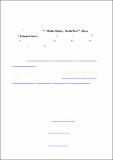Por favor, use este identificador para citar o enlazar a este item:
http://hdl.handle.net/10261/122981COMPARTIR / EXPORTAR:
 SHARE SHARE
 CORE
BASE CORE
BASE
|
|
| Visualizar otros formatos: MARC | Dublin Core | RDF | ORE | MODS | METS | DIDL | DATACITE | |

| Título: | Twenty-year advanced DInSAR analysis of severe land subsidence: The Alto Guadalentín Basin (Spain) case study |
Autor: | Bonì, Roberta; Herrera García, Gerardo; Meisina, Claudia; Notti, Davide; Béjar Pizarro, Marta; Zucca, Francesco; González, Pablo J. CSIC ORCID ; Palano, Mimmo; Tomás, Roberto; Fernández Torres, José CSIC ORCID ; Fernández Merodo, José Antonio; Mulas de la Peña, Joaquín; Aragón, Ramón; Guardiola Albert, Carolina CSIC ORCID; Mora, Óscar | Palabras clave: | Land subsidence Persistent Scatterer Interferometry (PSI) Spatio-temporal analysis Lorca Groundwater level GPS |
Fecha de publicación: | 11-ago-2015 | Editor: | Elsevier | Citación: | Engineering Geology, 198: 40–52 (2015) | Resumen: | A twenty-year period of severe land subsidence evolution in the Alto Guadalentín Basin (southeast Spain) is monitored using multi-sensor SAR images, processed by advanced differential interferometric synthetic aperture radar (DInSAR) techniques. The SAR images used in this study consist of four datasets acquired by ERS-1/2, ENVISAT, ALOS and COSMO-SkyMed satellites between 1992 and 2012. The integration of ground surface displacement maps retrieved for different time periods allows us to quantify up to 2.50 m of cumulated displacements that occurred between 1992 and 2012 in the Alto Guadalentín Basin. DInSAR results were locally compared with global positioning system (GPS) data available for two continuous stations located in the study area, demonstrating the high consistency of local vertical motion measurements between the two different surveying techniques. An average absolute error of 4.6 ± 4 mm for the ALOS data and of 4.8 ± 3.5 mm for the COSMO-SkyMed data confirmed the reliability of the analysis. The spatial analysis of DInSAR ground surface displacement reveals a direct correlation with the thickness of the compressible alluvial deposits. Detected ground subsidence in the past 20 years is most likely a consequence of a 100–200 m groundwater level drop that has persisted since the 1970s due to the overexploitation of the Alto Guadalentín aquifer system. The negative gradient of the pore pressure is responsible for the extremely slow consolidation of a very thick (> 100 m) layer of fine-grained silt and clay layers with low vertical hydraulic permeability (approximately 50 mm/h) wherein the maximum settlement has still not been reached. | Versión del editor: | http://dx.doi.org/10.1016/j.enggeo.2015.08.014 | URI: | http://hdl.handle.net/10261/122981 | DOI: | 10.1016/j.enggeo.2015.08.014 | ISSN: | 0013-7952 |
| Aparece en las colecciones: | (IGEO) Artículos (IGME) Artículos |
Ficheros en este ítem:
| Fichero | Descripción | Tamaño | Formato | |
|---|---|---|---|---|
| EG_2015_198_40.pdf | 3,09 MB | Adobe PDF |  Visualizar/Abrir |
CORE Recommender
SCOPUSTM
Citations
67
checked on 01-abr-2024
WEB OF SCIENCETM
Citations
66
checked on 21-feb-2024
Page view(s)
487
checked on 23-abr-2024
Download(s)
429
checked on 23-abr-2024
Google ScholarTM
Check
Altmetric
Altmetric
Este item está licenciado bajo una Licencia Creative Commons

